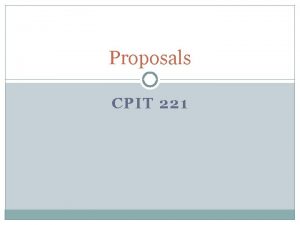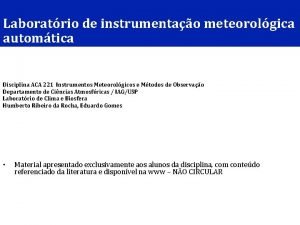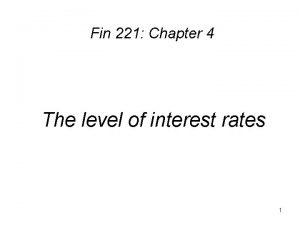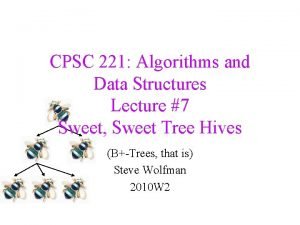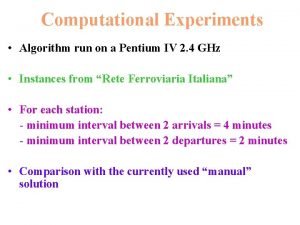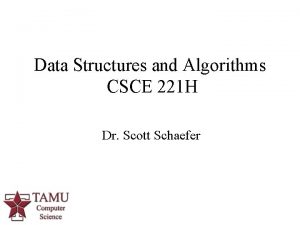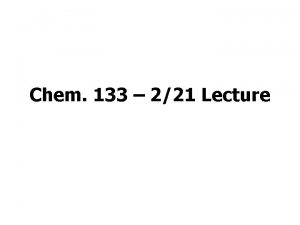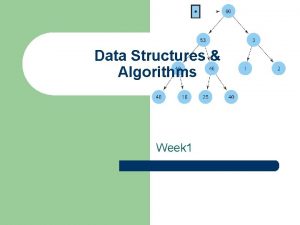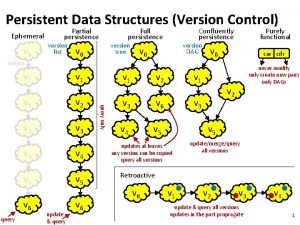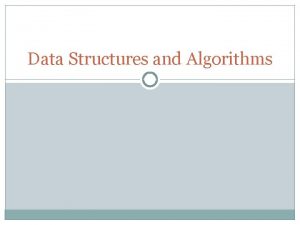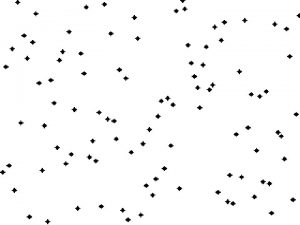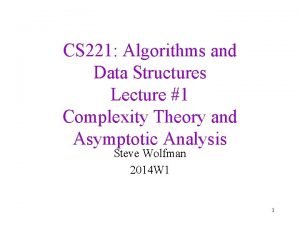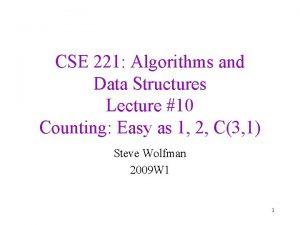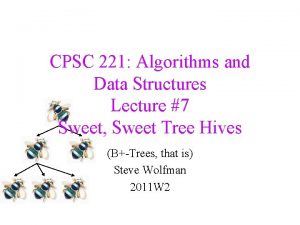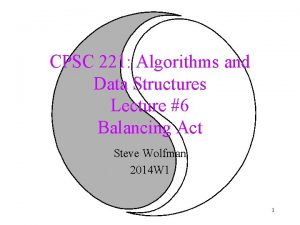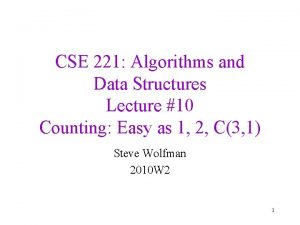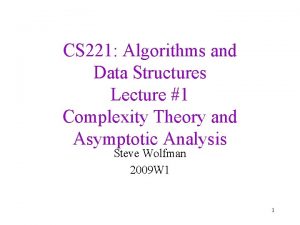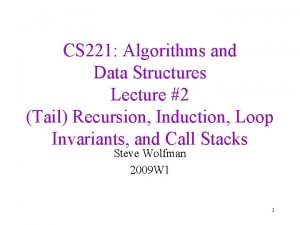CS 221 Algorithms and Data Structures Lecture 2

























![Insertion Sort (invariant) int insertion. Sort(int array[], int length) { // Invariant: before each Insertion Sort (invariant) int insertion. Sort(int array[], int length) { // Invariant: before each](https://slidetodoc.com/presentation_image_h/14b5937bd83614d42e3f57bddf217732/image-26.jpg)
































- Slides: 58

CS 221: Algorithms and Data Structures Lecture #2 (Tail) Recursion, Induction, Loop Invariants, and Call Stacks Steve Wolfman 2014 W 1 1

Today’s Outline • • • Thinking Recursively Recursion Examples Analyzing Recursion: Induction and Recurrences Analyzing Iteration: Loop Invariants Mythbusters: “Recursion’s not as efficient as iteration”? ? – Recursion and the Call Stack – Iteration and Explicit Stacks – Tail Recursion (but our KW text is wrong about this!) 2

Random String Permutations (reigniou. S m. PRrtmnsdtan aot) Problem: Permute a string so that every reordering of the string is equally likely. You may use a function randrange(n), which selects a number [0, n) uniformly at random. 3

Random String Permutations Understanding the Problem A string is: an empty string or a letter plus the rest of the string. We want every letter to have an equal chance to end up first. We want all permutations of the rest of the string to be equally likely to go after. And. . there’s only one empty string. (Tests: tricky, but result should always have same letters as orginal. ) 4

Random String Permutations Algorithm PERMUTE(s): if s is empty, just return s else: use rand. Range to choose a random first letter permute the rest of the string (minus that random letter) return a string that starts with the random letter and continues with the permuted rest of the string 5

Random String Permutations Converting Algorithm to Code PERMUTE(s): if s is empty, just return s else: choose random letter permute the rest return random letter + rest 6

Thinking Recursively DO NOT START WITH CODE. Write the story of the problem, including the data definition! Define the problem: What should be done given a particular input? Solve some example cases by hand. Identify and solve the (usually simple) base case(s). Figure out how to break the complex cases down in terms of any smaller case(s). For the smaller cases, call the function recursively and assume it 7 works. Do not think about how!

Implementing Recursion (REMINDER!) Once you have all that, write out your solution in comments (a “template”). Then fill out the code and test. (Should be easy… if it’s hard, maybe you’re not assuming your recursive call works!) 8

Recursion Example: Fibs (SKIPPING in class) Problem: Calculate the nth Fibonacci number, from the sequence 1, 1, 2, 3, 5, 8, 13, 21, 34, 55, . . . First two numbers are 1; each succeeding number is the sum of the previous two numbers: 9

Fibs, Worked, First Pass (SKIPPING in class) Problem: Calculate the nth Fibonacci number, from the sequence 1, 1, 2, 3, 5, 8, 13, 21, 34, 55, . . . int fib(int n) { if (n <= 2) return 1; else return fib(n-1) + fib(n-2); } 10

Today’s Outline • • • Thinking Recursively Recursion Examples Analyzing Recursion: Induction and Recurrences Analyzing Iteration: Loop Invariants Mythbusters: “Recursion’s not as efficient as iteration”? ? – Recursion and the Call Stack – Iteration and Explicit Stacks – Tail Recursion (but our KW text is wrong about this!) 11

Induction and Recursion, Twins Separated at Birth? Base case Prove for some small value(s). Base case Calculate for some small value(s). Inductive Step Break a larger case down into smaller ones that we assume work (the Induction Hypothesis). Otherwise, break the problem down in terms of itself (smaller versions) and then call this function to solve the smaller versions, assuming it will work. 12

Proving a Recursive Function Correct with Induction is EASY Just follow your code’s lead and use induction. Your base case(s)? Your code’s base case(s). How do you break down the inductive step? However your code breaks the problem down into smaller cases. What do you assume? That the recursive calls just work (for smaller input sizes as parameters, which better be how your recursive code works!). 13

Reminder: Factorial • 14

Proving a Recursive Function Correct with Induction is EASY // Precondition: n >= 0. // Postcondition: returns n! int factorial(int n) { if (n == 0) return 1; else return n*factorial(n-1); } ALWAYS connect what the code does with what you want to prove. Prove: factorial(n) = n! Base case: n = 0. Our code returns 1 when n = 0, and 0! = 1 by definition. Inductive step: For some k > 0, our code returns k*factorial(k-1). By IH, factorial(k-1) = (k-1)! and k! = k*(k-1)! by 15 definition. QED

Proving A Recursive Algorithm Works Problem: Prove that our algorithm for randomly permuting a string gives an equal chance of returning every permutation (assuming randrange(n) works as advertised).

Recurrence Relations… Already Covered See METYCSSA #5 -7. Additional Problem: Prove binary search takes O(lg n) time. // Search array[left. . right] for target. // Return its index or the index where it should go. int b. Search(int array[], int target, int left, int right) { if (right < left) return left; int mid = (left + right) / 2; if (target <= array[mid]) return b. Search(array, target, left, mid-1); else return b. Search(array, target, mid+1, right); } 17

Binary Search Problem (Worked) Note: Let n be # of elements considered in the array (right – left + 1). int b. Search(int array[], int target, int left, int right) { if (right < left) return left; O(1), base case int mid = (left + right) / 2; O(1) if (target <= array[mid]) O(1) ~T(n/2) return b. Search(array, target, left, mid-1); else return b. Search(array, target, mid+1, right); ~T(n/2) } 18

Binary Search Problem (Worked) For n=0: T(0) = 1 For n>0: T(n) = T( n/2 ) + 1 To guess at the answer, we simplify: For n=1: T(1) = 1 For n>1: T(n) = T(n/2) + 1 T(n) = (T(n/4) + 1 T(n) = T(n/4) + 2 T(n) = T(n/8) + 3 T(n) = T(n/16) + 4 T(n) = T(n/(2 i)) + i Change n/2 to n/2. Change base case to T(1) (We’ll never reach 0 by dividing by 2!) Sub in T(n/2) = T(n/4)+1 Sub in T(n/4) = T(n/8)+1 Sub in T(n/8) = T(n/16)+1 19

Binary Search Problem (Worked) To guess at the answer, we simplify: For n=1: T(1) = 1 For n>1: T(n) = T(n/2) + 1 For n>1: T(n) = T(n/(2 i)) + i To reach the base case, let n/2 i = 1 n = 2 i means i = lg n Why did that work out so well? T(n) = T(n/2 lg n) + lg n = T(1) + lg n = lg n + 1 T(n) O(lg n) 20

Binary Search Asymptotic Performance, Proof by Induction For n=0: T(0) = 1 For n>0: T(n) = T( n/2 ) + 1 T(1) = T(0) + 1 = 2 T(2) = T(3) = T(1) + 1 = 3. Prove T(n) O(lg n) Set n 0 = 2 because lg 0 is undefined and lg 1 = 0. We want c lg 2 T(2) and we know T(2) = 3. Let c = 3, n 0 = 2. Show for all n n 0, T(n) c lg n. Base cases: T(2) = 3 lg 2 Base cases: T(3) = 3 3 lg 3 Solve for c: c 3/lg 2 = 3. 21

Binary Search Problem (Worked) • 22

Today’s Outline • • • Thinking Recursively Recursion Examples Analyzing Recursion: Induction and Recurrences Analyzing Iteration: Loop Invariants Mythbusters: “Recursion’s not as efficient as iteration”? ? – Recursion and the Call Stack – Iteration and Explicit Stacks – Tail Recursion (but our KW text is wrong about this!) 23

(Tail) Recursive Iterative It’s often simple to convert a recursive function to an iterative one (and vice versa). int b. Search(int array[], int target, int left, int right) { if (right < left) return left; while (!(right < left)) int mid = (left + right) / 2; if (target <= array[mid]) return b. Search(array, target, left, mid-1); right = mid – 1; else return b. Search(array, target, mid+1, right); left = mid + 1; } return left; } 24

Analyzing Loops Maybe we can use the same techniques we use for proving correctness of recursion to prove correctness of loops. . . We do this by stating and proving “invariants”, properties that are always true (don’t vary) at particular points in the program. One way of thinking of a loop is that we spend each loop iteration fixing the invariant for the next iteration. 25
![Insertion Sort invariant int insertion Sortint array int length Invariant before each Insertion Sort (invariant) int insertion. Sort(int array[], int length) { // Invariant: before each](https://slidetodoc.com/presentation_image_h/14b5937bd83614d42e3f57bddf217732/image-26.jpg)
Insertion Sort (invariant) int insertion. Sort(int array[], int length) { // Invariant: before each test i < length (including the last // one), the elements in array[0. . i-1] are in sorted order. for (int i = 1; i < length; i++) { // i is about to go up by 1 but array[i] may be out of order! // gotta fix it!!! int val = array[i]; int new. Index = b. Search(array, val, 0, i); for (int j = i; j > new. Index; j--) array[j] = array[j-1]; array[new. Index] = val; (invariant anxiety) } } 26

Proving a Loop Invariant Induction variable: number of times through the loop. Base case: Prove the invariant true before the first loop guard test. Induction hypothesis: Assume the invariant holds just before some (unspecified) iteration’s loop guard test. Inductive step: Prove the invariant holds at the end of that iteration (just before the next loop guard test). Extra bit: Make sure the loop will eventually end! We’ll prove insertion sort works, but the cool part is not proving it works (duh). 27 The cool part is that the proof is a natural way to think about it working!

Proving Insertion Sort Works // Invariant: before each test i < length (including the last // one), the elements in array[0. . i-1] are in sorted order. for (int i = 1; i < length; i++) { // i is about to go up by 1 but array[i] may be out of order! int val = array[i]; int new. Index = b. Search(array, val, 0, i); for (int j = i; j > new. Index; j--) array[j] = array[j-1]; array[new. Index] = val; } Base case (just before “ 1 < length”): array[0. . 0] has one element; so, it’s always in sorted order. What’s the niggly detail we skipped here? 28

Proving Insertion Sort Works // Invariant: before each test i < length (including the last // one), the elements in array[0. . i-1] are in sorted order. for (int i = 1; i < length; i++) { // i is about to go up by 1 but array[i] may be out of order! int val = array[i]; int new. Index = b. Search(array, val, 0, i); for (int j = i; j > new. Index; j--) array[j] = array[j-1]; array[new. Index] = val; } Induction hypothesis: just before we test k < length, array[0. . k-1] are in sorted order. (When the loop starts, i = k. ) 29

Proving Insertion Sort Works // Invariant: before each test i < length (including the last // one), the elements in array[0. . i-1] are in sorted order. for (int i = 1; i < length; i++) { // i is about to go up by 1 but array[i] may be out of order! int val = array[i]; (surprisingly: linear search int new. Index = b. Search(array, val, 0, i); may be a better choice here; for (int j = i; j > new. Index; j--) ask after class!) array[j] = array[j-1]; array[new. Index] = val; } Inductive Step: b. Search gives the appropriate index at which to put array[i]. So, the new element ends up in sorted order, and the rest of array[0. . i] stays in sorted order. 30 (A bit hand-wavy… what should we have done? )

Proving Insertion Sort Works // Invariant: before each test i < length (including the last // one), the elements in array[0. . i-1] are in sorted order. for (int i = 1; i < length; i++) { // i is about to go up by 1 but array[i] may be out of order! int val = array[i]; int new. Index = b. Search(array, val, 0, i); for (int j = i; j > new. Index; j--) array[j] = array[j-1]; array[new. Index] = val; } Loop termination: The loop ends when i == length (which it must be eventually since length is non-negative and i increases). At which point, array[0. . i-1] is sorted… which 31 is array[0. . length-1] or the whole array

Practice: Prove the Inner Loop Correct for (int i = 1; i < length; i++) { // i is about to go up by 1 but array[i] may be out of order! int val = array[i]; int new. Index = b. Search(array, val, 0, i); // What’s the invariant? Maybe: just before j > new. Index, // “array[0. . j-1] + array[j+1. . i] = the old array[0. . i-1]” for (int j = i; j > new. Index; j--) array[j] = array[j-1]; array[new. Index] = val; } We just waved our hands at the inner loop. Prove it’s correct! (This may feel unrealistically easy!) Do note that j is going down, not up. 32

Today’s Outline • • • Thinking Recursively Recursion Examples Analyzing Recursion: Induction and Recurrences Analyzing Iteration: Loop Invariants Mythbusters: “Recursion’s not as efficient as iteration”? ? – Recursion and the Call Stack – Iteration and Explicit Stacks – Tail Recursion (but our KW text is wrong about this!) 33

Mythbusters: Recursion vs. Iteration Which one can do more? Recursion or iteration? 34

Mythbusters: Simulating a Loop with Recursion int i = 0 while (i < n) do. Foo(i) i++ rec. Do. Foo(0, n) Where rec. Do. Foo is: void rec. Do. Foo(int i, int n) { if (i < n) { do. Foo(i) rec. Do. Foo(i + 1, n) } } Anything we can do with iteration, we can do with recursion. 35

Mythbusters: Simulating Recursion with a Stack (Going Quick. . Already Discussed) How does fib actually work? Each function call generates a stack frame (also known as activation record or, just between us, function pancake) holding local variables and the program point to return to, which is pushed on a stack (the call stack) that tracks the current chain of function calls. int fib(int n) { if (n <= 2) return 1; else return fib(n-1) + fib(n-2); } cout << fib(4) << endl; 36

Mythbusters: Simulating Recursion with a Stack (Going Quick. . Already Discussed) How does fib actually work? int fib(int n) { if (n <= 2) return 1; else return fib(n-1) + fib(n-2); } cout << fib(4) << endl; The call (or “run-time”) stack main fib(2) fib(3) fib(4) main fib(3) fib(4) main fib(1) fib(2) fib(3) fib(4) fib(4) main main Time 37

Aside: Efficiency and the Call Stack The height of the call stack tells us the maximum memory we use storing the stack. height = 4 frames fib(2) fib(3) fib(4) main fib(3) fib(4) main fib(1) fib(3) fib(2) fib(4) fib(4) main main The number of calls that go through the call stack tells us something about time usage. (The # of calls multiplied by worst-case time per call bounds the asymptotic complexity. ) So, when calculating memory usage, we must consider stack space! 38 But only the non-tail-calls count… see later slides on tail recursion and tail calls.

Aside: Limits of the Call Stack int fib(int n) { if (n == 1) return 1; else if (n == 2) return 1; else return fib(n-1) + fib(n-2); } cout << fib(0) << endl; What will happen? a. Returns 1 immediately. b. Runs forever (infinite recursion) c. Stops running when n “wraps around” to positive values. d. Bombs when the computer runs out of stack space. e. None of these. 39

Mythbusters: Simulating Recursion with a Stack How do we simulate fib with a stack? That’s what our computer already does. We can sometimes do it a bit more efficiently by only storing what’s really needed on the stack: int fib(int n) result = 0 push(n) while not is. Empty n = pop if (n <= 2) result++; else push(n – 1); push(n – 2) return result OK, this is cheating a bit (in a good way). 40 To get down and dirty, see CPSC 313 + 311.

Mythbusters: Recursion vs. Iteration Which one is more elegant? Recursion or iteration? 41

Mythbusters: Recursion vs. Iteration Which one is more efficient? Recursion or iteration? 42

Accidentally Making Lots of Recursive Calls; Recall. . . • Recursive Fibonacci: int Fib(n) if (n == 0 or n == 1) return 1 else return Fib(n - 1) + Fib(n - 2) • Lower bound analysis • T(0), T(1) >= b T(n) >= T(n - 1) + T(n - 2) + c if n > 1 • Analysis let be (1 + 5)/2 which satisfies 2 = + 1 show by induction on n that T(n) >= b n - 1 43 Already discussed Day 1. . Skipping.

Accidentally Making Lots of Recursive Calls; Recall. . . int Fib(n) if (n == 1 or n == 2) return 1 else return Fib(n - 1) + Fib(n - 2) Finish the recursion tree for Fib(5)… Fib (5) Fib (4) Fib (3) 44 Already discussed Day 1. . Skipping.

Fixing Fib: Requires Iteration? What we really want is to “share” nodes in the recursion tree: Fib (5) Fib (4) Fib (3) Fib (2) Fib (1) 45 Already discussed Day 1. . Skipping.

Fixing Fib with Iteration and “Dynamic Programming” Here’s one fix that “walks up” the left of the tree: int fib_dp(int n) { Fib if (n == 1) return 1; (5) int fib = 1, fib_old = 1; Fib int i = 2; (4) while (i < n) { int fib_new = fib + fib_old; Fib fib_old = fib; (3) fib = fib_new; i++; Fib (2) (1) } return fib; 46 } Already discussed Day 1. . Skipping.

Fixing Fib with Recursion and “Memoizing” Here’s another fix that just takes note of problems it’s solved before: int[] fib_solns = new int[large_enough]; // init to 0 fib_solns[1] = 1; Fib fib_solns[2] = 1; (5) int fib_memo(int n) { Fib (4) // If we don’t know the answer… if (fib_solns[n] == 0) Fib fib_solns[n] = fib_memo(n-1) + (3) fib_memo(n-2); return fib_solns[n]; Fib (2) (1) } 47 Already discussed Day 1. . Skipping.

Fixing Fib with Recursion and Pure Functional Programming In a “pure functional” programming language (like Haskell and a subset of Racket), the interpreter can (but may not) notice that nodes in the graph are the same and share them. Fib (5) Fib (4) Fib (3) Fib (2) Fib (1) Fib (4) Fib (3) Fib (2) Fib (3) Fib (1) Fib (2) Fib (1) 48 Why? Because Fib(n) can never return two different values in a pure functional language.

Mythbusters: Recursion vs. Iteration Which one is more efficient? Recursion or iteration? It’s probably easier to shoot yourself in the foot without noticing when you use recursion, and the call stack may carry around a bit more (a constant factor more) memory than you really need to store, but otherwise… Neither is more efficient. 49 Before we move, on, let’s lather, rinse, and repeat.

Managing the Call Stack: Tail Recursion void shampoo() { cout << "Lather, Rinse" << endl; shampoo(); } This is clearly infinite recursion. The call stack will get as deep as it can get and then bomb, right? But. . . why? What work is the call stack doing? There’s nothing to remember on the stack! Try compiling it with at least –O 2 optimization and running. It won’t give a stack overflow! 50

Tail Call (should be CPSC 110 review!) A function call is a “tail call” if that call is the absolute last thing the function needs to do before returning. In that case, why bother pushing a new stack frame? There’s nothing to remember. Just re-use the old frame. That’s what most compilers will do (although Java has had some issues with this!). 51

Tail Recursion (should be CPSC 110 review!) A function is “tail recursive” if all of its recursive calls are tail calls (i. e. , each recursive call in the function is the absolute last thing the function needs to do before returning). Can two calls both be the last thing that needs to be done before the function returns? Sure: consider binary search: we recurse to the left or to the right, but not both. WARNING: Koffman and Wolfgang text is wrong about this! 52 Having a (or even “the”) recursive call on the last line is not enough.

Tail Recursive? int fib(int n) { if (n <= 2) return 1; else return fib(n-1) + fib(n-2); } Tail recursive? a. Yes. b. No. c. Not enough information. 53

Tail Recursive? int factorial(int n) { if (n == 0) return 1; else return n * factorial(n – 1); } Tail recursive? a. Yes. b. No. c. Not enough information. 54

Tail Recursive? int factorial(int n) { return fact_acc(n, 1); } int fact_acc (int n, int acc) { if (n == 0) return acc; else return fact_acc(n – 1, acc * n); } Tail recursive? a. Yes. b. No. c. Not enough information. 55

Tail Calls int fact(int n) { return fact_acc(n, 1); } int fact_acc (int n, int acc) { if (n == 0) return acc; else return fact_acc(n – 1, acc * n); } The call to fact_acc in factorial is a tail call and therefore also need not consume extra stack space. 56

To Do • CPSC 121 Review: Epp 4. 2 -4. 4, 5. 1 -5. 2, 7. 1 -7. 2 • Read: Epp 4. 5, Koffman/Wolfgang Chapter 7 57

Coming Up • One of (TBD!): – Priority Queues – Trees 58
 Data structures and algorithms iit bombay
Data structures and algorithms iit bombay Cos423
Cos423 Data structures and algorithms tutorial
Data structures and algorithms tutorial Information retrieval data structures and algorithms
Information retrieval data structures and algorithms Data structures and algorithms bits pilani
Data structures and algorithms bits pilani Ajit diwan iitb
Ajit diwan iitb Data structures and algorithms
Data structures and algorithms Data structures and algorithms
Data structures and algorithms Waterloo data structures and algorithms
Waterloo data structures and algorithms Signature file structure in information retrieval system
Signature file structure in information retrieval system Data structures and algorithms
Data structures and algorithms Algorithms + data structures = programs
Algorithms + data structures = programs Analysis of algorithms lecture notes
Analysis of algorithms lecture notes Introduction to algorithms lecture notes
Introduction to algorithms lecture notes 01:640:244 lecture notes - lecture 15: plat, idah, farad
01:640:244 lecture notes - lecture 15: plat, idah, farad Give other examples of homologous structures
Give other examples of homologous structures Muthukrishnan data stream algorithms
Muthukrishnan data stream algorithms Csce 221 tamu syllabus
Csce 221 tamu syllabus Phy 221 msu
Phy 221 msu 866-221-0269
866-221-0269 Cap 221
Cap 221 Sp 221
Sp 221 Emmett school district bond
Emmett school district bond Epsc 221
Epsc 221 Cinda heeren ubc
Cinda heeren ubc Csce 221
Csce 221 Cpit 221
Cpit 221 221 bce
221 bce Cpit221
Cpit221 1053 enteros 246 milésimos
1053 enteros 246 milésimos Aca 221
Aca 221 Fin 221
Fin 221 Cse 221
Cse 221 Cs 221
Cs 221 Cpsc 221
Cpsc 221 Lagr 221
Lagr 221 Sebuah kapasitor
Sebuah kapasitor Aoi 221 gate
Aoi 221 gate Edu-221
Edu-221 Gs-221
Gs-221 Cse 221
Cse 221 Ee 221
Ee 221 221 ad
221 ad Gs-221
Gs-221 Bio 221
Bio 221 Einstein flow cytometry
Einstein flow cytometry 221 bc
221 bc If 221
If 221 866-221-0269
866-221-0269 Cps 221
Cps 221 Csce 222
Csce 222 Ee 221
Ee 221 133 221
133 221 One pass macro processor
One pass macro processor Assembler algorithm and data structures
Assembler algorithm and data structures Data structures and abstractions with java
Data structures and abstractions with java Adts, data structures, and problem solving with c++
Adts, data structures, and problem solving with c++ Data structures and algorithm
Data structures and algorithm Persistent and ephemeral data structures
Persistent and ephemeral data structures




























